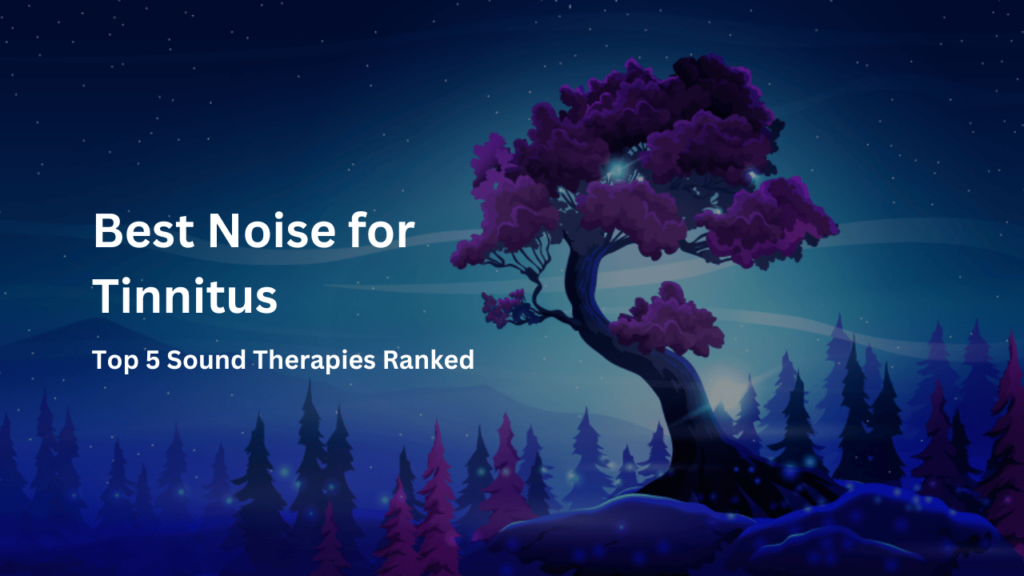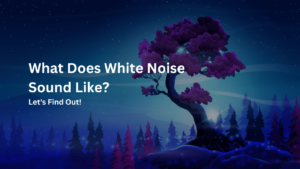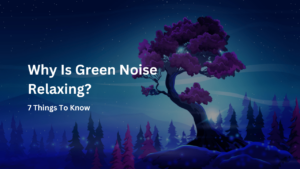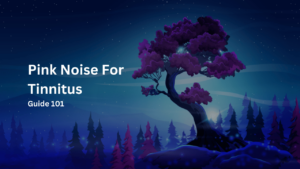Tinnitus, the perception of sound in the absence of an external source, can significantly impact one’s quality of life. While there’s no one-size-fits-all solution, sound therapy has emerged as a highly effective approach for many.
This comprehensive guide ranks the top 5 sound therapies for tinnitus relief, highlighting their unique benefits and practical applications.

1. Green Noise: The Sound of Serenity
Green noise for tinnitus is characterised by the soothing sounds of nature, stands out as the premier choice for many tinnitus sufferers. It encompasses the tranquil sounds of rustling leaves, gentle breezes, and distant waterfalls, reminiscent of a peaceful forest.
The natural quality of green noise not only masks the tinnitus but also promotes relaxation and stress reduction, crucial for managing tinnitus symptoms.
Benefits:
- Stress Reduction: The calming effect of green noise can significantly lower stress levels, which are often linked to the intensity of tinnitus symptoms.
- Improved Sleep: By creating a serene auditory environment, green noise can facilitate a quicker onset of sleep and a deeper sleep state, essential for those with tinnitus-related insomnia.
- Enhanced Concentration: The gentle backdrop of green noise can improve focus by masking the distracting sounds of tinnitus, making it ideal for work or study.
2. Pink Noise: Balanced and Soothing
Pink noise in tinnitus offers a balanced sound across the frequency spectrum, with a slight emphasis on lower frequencies. It’s akin to the sound of steady rain or soft wind and is known for its ability to improve sleep quality and memory recall.
Benefits:
- Sound Masking: Pink noise effectively masks the sounds of tinnitus, providing immediate relief from its persistent noise.
- Sleep Quality: The consistent flow of pink noise can enhance sleep quality, making it easier to fall asleep and stay asleep.
- Memory Improvement: Studies suggest that listening to pink noise can boost memory, a welcome benefit for anyone, especially those struggling with sleep disturbances due to tinnitus.
3. White Noise: The Classic Choice
White noise is a well-known sound therapy option, incorporating a mix of all audible frequencies at equal intensity. It’s comparable to the static of a detuned radio or the hum of an air conditioner.
Benefits:
- Versatility: White noise in tinnitus can mask a wide range of sounds, making it a versatile option for many sufferers.
- Improved Concentration: The consistent sound of white noise can help drown out tinnitus, aiding concentration and productivity.
- Sleep Aid: Its ability to create a consistent auditory environment can help mitigate the impact of tinnitus on sleep.
4. Brown Noise: Deep and Resonant
Brown noise for Tinnitus emphasis on lower frequencies, resembles the deep, continuous rumble of a thunderstorm or a strong waterfall. Its richness and depth make it particularly effective for deeper sound masking and relaxation.
Benefits:
- Deep Masking: Brown noise’s lower frequencies can mask deeper tones of tinnitus, providing comfort to those for whom high-pitched therapies like white noise might not be as effective.
- Relaxation: The deep, resonant quality of brown noise can promote relaxation and reduce stress, aiding in overall tinnitus management.
- Sleep Enhancement: Its soothing properties can help individuals fall asleep faster and enjoy a more restful night’s sleep.
5. Customised Sound Therapy: Tailored to Your Needs
Customised sound therapy involves creating a personalised sound profile based on an individual’s specific tinnitus characteristics.
This approach often requires working with a hearing specialist and can include a combination of sound tracks tailored to mask or distract from the individual’s tinnitus.
Benefits:
- Personalization: By tailoring the sound therapy to the specific frequencies of one’s tinnitus, this approach can offer more effective relief.
- Flexibility: Customised sound therapy can be adjusted over time to adapt to changes in tinnitus perception, ensuring ongoing effectiveness.
- Comprehensive Management: This method can be integrated into a broader tinnitus management plan, including behavioural therapy and stress management techniques.
Frequently Asked Questions (FAQs)
Q1: What is the masking sound for tinnitus?
Ans: White noise, pink noise, brown noise and customised acoustic stimuli are commonly used masking sounds that can cover up the phantom noises of tinnitus.
Q2: What is a tinnitus blocker?
Ans: Devices like hearing aids and noise generators that produce steady background sounds serve as tinnitus blockers that divert attention from ear ringing.
Q3: What frequency blocks tinnitus?
Ans: Soothing sounds ranging from low-frequency noise to broad-frequency white noise can mask the specific pitch perceived by those with tinnitus.
Q4: Is Pink Noise best for tinnitus?
Ans: Pink noise for tinnitus relief is very effective because of its calming quality and ability to mask ringing well. But other noises also help.
Q5: Is Brown Noise better for tinnitus?
Ans: Brown noise can potentially mask lower-pitched tinnitus tones. No definitive evidence says it’s better overall than white or pink noise though.
Q6: Does green noise help tinnitus?
Ans: Yes, mid-range green noise can mask tinnitus noise for certain people, especially with ringing centred in those frequencies.
Conclusion
Sound therapy offers a promising avenue for tinnitus relief, with each type of noise therapy providing unique benefits. Green noise stands out for its natural, calming properties, making it an excellent choice for stress reduction and improved sleep. However, the effectiveness of sound therapy is highly individual
Experimenting with different types of noise and consulting with a healthcare professional can help you find the most effective relief for your tinnitus symptoms, leading to a better quality of life.



